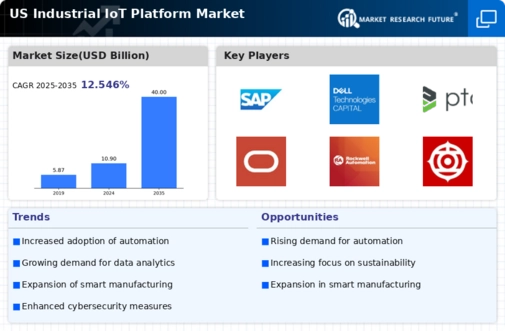The US Industrial IoT Platform Market is experiencing significant growth driven by the increasing demand for smart manufacturing, enhanced operational efficiency, and data-driven decision-making processes. As industries continue to embrace digital transformation, a competitive landscape has emerged where companies are focusing on developing robust IoT solutions that can seamlessly integrate with existing infrastructure and deliver actionable insights. In this market, the race is on to capture a larger share by leveraging technologies such as machine learning, big data analytics, and advanced connectivity.
Organizations are investing heavily in research and development to innovate their service offerings, streamline operations, and expand their market presence, leading to a dynamic environment that requires constant adaptation and strategic positioning.SAP has established itself as a formidable player in the US Industrial IoT Platform Market, leveraging its comprehensive suite of solutions that enhance enterprise resource planning and offer operational visibility. With a strong emphasis on integration and interoperability, SAP’s offerings allow businesses to harness real-time data to drive efficiency and optimize performance across various sectors such as manufacturing, logistics, and supply chain management.
The company’s strength lies in its ability to provide end-to-end solutions tailored to the specific needs of industries, enabling smooth transitions to digital frameworks. SAP's focus on innovation through robust partnerships and collaboration with industry stakeholders further solidifies its competitive advantage in the US market, positioning it as a go-to provider for organizations keen on advancing their IoT capabilities.Dell Technologies has also made significant strides in the US Industrial IoT Platform Market by providing a range of hardware and software solutions that cater to the needs of connected devices and data analytics.
The company’s edge computing solutions, powerful data storage options, and cloud services are integral to building an effective IoT ecosystem. Dell Technologies emphasizes its strengths in delivering scalable infrastructure that supports various applications in smart factories, logistics, and asset management. Additionally, the company has pursued a strategy of growth through key acquisitions that enhance its portfolio and technological capabilities in the IoT space. By offering tailored solutions that address complex industrial challenges, Dell Technologies maintains a competitive presence in the US, facilitating innovation and driving customer success in the rapidly evolving Industrial IoT landscape.
























